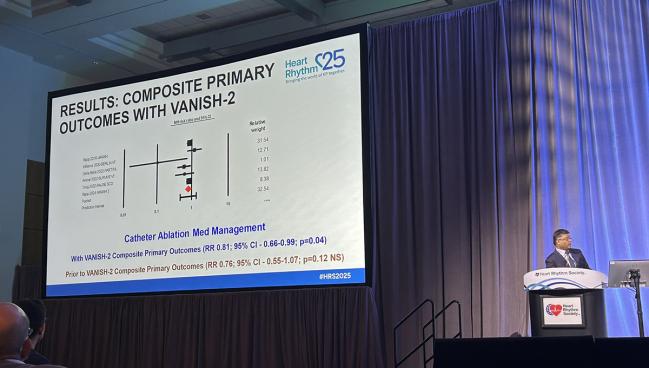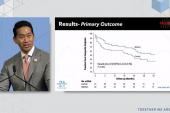VANISH2 Bolsters Data Backing VT Ablation in Ischemic Cardiomyopathy
The US guidelines are likely to change following the release of the VANISH2 results last year, Christine Albert anticipates.

SAN DIEGO, CA—Catheter ablation for ventricular arrhythmias is beneficial for patients with ischemic cardiomyopathy, affirms a new meta-analysis updated to include the VANISH2 trial results.
Compared with medical management, ablation was associated with lower rates of recurrent ventricular arrhythmias, implantable cardioverter-defibrillator (ICD) shocks, ventricular tachycardia (VT) storm, hospitalization, and major adverse cardiac events, Girish Nair, MBBS (University of Ottawa Heart Institute, Canada), reported here at Heart Rhythm 2025.
The addition of the positive VANISH2 trial to the evidence base “reinforces that catheter ablation is superior to medical management,” Nair said. “It has refined the estimation of catheter ablation for management of ventricular arrhythmias, and due to the difficulty of replicating the trial, it probably strengthens our conviction that catheter ablation does work in this situation.”
Results from VANISH2, released in November 2024, showed that first-line catheter ablation reduced a composite of death or serious arrhythmia outcomes compared with antiarrhythmic drugs in patients with ischemic cardiomyopathy, clinically significant VT, and an ICD.
Dhanunjaya Lakkireddy, MD (Kansas City Heart Rhythm Institute and Research Foundation, Overland Park, KS), abstract chair for the Heart Rhythm Society, said catheter ablation is an important strategy that should be considered to reduce the overall morbidity associated with ventricular arrhythmias.
“There is this concept that VT ablations are difficult, VT ablations are complex, and that before you consider VT ablation, somehow people have to go through a whole barrage of antiarrhythmic drugs,” he told TCTMD, adding that the side effects of those medications are “grossly underappreciated in the real world.”
What this new analysis suggests, Lakkireddy said, is that “early intervention could potentially change the trajectory of how these patients are going to do.”
Incorporating VANISH2
Ventricular arrhythmias are associated with adverse outcomes like death and ICD shocks, which can cause posttraumatic stress disorder and even severe depression in some patients, said Nair.
For many years, the only treatment for ventricular arrhythmias was antiarrhythmic drugs, but catheter ablation has since been used to reduce overall arrhythmia burden, VT storm, ICD shocks, and adverse outcomes like heart failure, hospitalization, and death. There are, however, only a limited number of RCTs assessing the impact of VT ablation.
Nair and his colleagues added the VANISH2 results to a meta-analysis with the prior trials of VT ablation to see how they influenced the strength of the evidence. The pooled cohort included 10 trials and 1,440 patients, with 29% of them coming from VANISH2. Composite primary endpoints varied across the trials and included outcomes like all-cause or CV death, VT storm or recurrence, appropriate ICD shock, hospitalization for ventricular arrhythmia or congestive heart failure, and major treatment-related complications.
[VANISH2] has refined the estimation of catheter ablation for management of ventricular arrhythmias. Girish Nair
A meta-analysis without VANISH2 did not show a significant reduction in composite primary outcomes with VT ablation versus medical management (risk ratio [RR] 0.76; 95% CI 0.55-1.07). The addition of VANISH2, however, narrowed the confidence interval and provided a significant difference favoring ablation (RR 0.81; 95% CI 0.66-0.99).
Catheter ablation also was associated with lower risks of the following outcomes:
- ICD shocks (RR 0.68; 95% CI 0.53-0.88)
- VT storm (RR 0.74; 95% CI 0.56-0.98)
- Recurrent VT (RR 0.85; 95% CI 0.73-0.98)
- Hospitalization (RR 0.82; 95% CI 0.68-0.98)
There was no difference between the ablation and medical management groups in mortality (RR 0.91; 95% CI 0.72-1.14). Nair noted that none of the included trials were powered to detect a difference in mortality and that these types of patients often have multiple comorbidities that result in competing death risks.
Nair acknowledged some limitations of the meta-analysis, including the relatively low numbers of trials and participants; differences in trial methodology and interventional strategies across studies; and differences in competing CV risk factors among the participants stemming from variations in inclusion/exclusion criteria and follow-up duration.
Guideline Changes Coming?
Christine Albert, MD (Cedars-Sinai Medical Center, Los Angeles, CA), study discussant and past president of the Heart Rhythm Society, noted that there are already indications for VT ablation in practice guidelines, pointing to a class I recommendation for catheter ablation in patients with an ICD and sustained VT despite treatment with amiodarone in the 2022 European Society of Cardiology guideline on ventricular arrhythmias and sudden cardiac death.
VANISH2 adds to the literature by providing data on ablation as a first-line approach over antiarrhythmic drug therapy, Albert said.
Early intervention could potentially change the trajectory of how these patients are going to do. Dhanunjaya Lakkireddy
But Albert also highlighted several limitations of the current meta-analysis related to the differences among the trials in patient mix, ablation protocols, control treatments, and composite outcomes. When heterogeneous studies are pooled, “sometimes it doesn’t work very well,” she said. “Combining studies with different populations, interventions, and outcomes really can sometimes even obscure real treatment effects or can lead to misleading results.”
The findings appear to show a benefit of ablation, Albert indicated. “But basically, VANISH2 is going to impact guidelines based upon its individual results, and this meta-analysis, unfortunately, can’t replace such a well-designed, large, controlled, randomized trial.”
Lakkireddy anticipated some changes as well. “I hope to see for the next VT guidelines that we should be able to offer VT ablation in appropriate cases as a first-line therapy,” he said.
Todd Neale is the Associate News Editor for TCTMD and a Senior Medical Journalist. He got his start in journalism at …
Read Full BioSources
Nair GM. Efficacy of catheter ablation for management of ventricular arrhythmias in subjects with ischemic cardiomyopathy: meta-analysis of randomized controlled trials including VANISH-2. Presented at: HRS 2025. April 26, 2025. San Diego, CA.
Disclosures
- Nair reports receiving institutional or personal grants/contracts from Abbott Canada, the Canadian Institutes of Health Research, the Heart and Stroke Foundation of Canada, Johnson & Johnson International, and Medtronic, and consulting for Boston Scientific.
- Albert reports serving on advisory committees or review panels for Boston Scientific, Element Science, Medtronic, and Novartis, and consulting for Illumina.





Comments